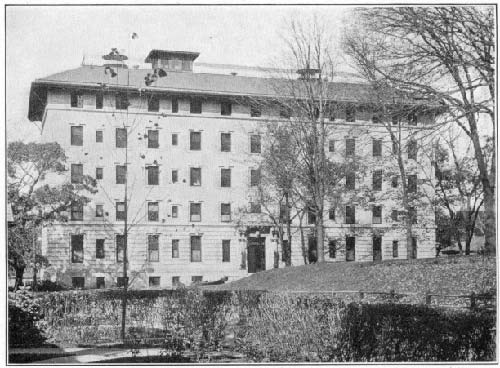Daniel Baird Wesson 1825 - 1906
May 01, 2008
 ** Daniel
Baird Wesson** 1825 -
1906 partnered with Horace
Smith in
Norwich, Connecticut in the early 1850s to develop the first repeating
rifle, the Volcanic
rifle. At the time of his
death Wesson was reported to be
worth
$50,000,00.
** Daniel
Baird Wesson** 1825 -
1906 partnered with Horace
Smith in
Norwich, Connecticut in the early 1850s to develop the first repeating
rifle, the Volcanic
rifle. At the time of his
death Wesson was reported to be
worth
$50,000,00.
Wesson was also an advocate of homeopathy.
Wesson was a friend of Springfield homeopath John Hosea Carmichael:
John Hosea Carmichael was the promoter of the Hampden Homœopathic Hospital and is in the management of the same. He was the originator of this institution and it was through his influence that it was donated by Daniel B. Wesson, of Springfield, Massachusetts.
John Hosea Carmichael is now largely interested in the construction of a new hospital in Springfield, which is to be one of the best in the country. It will cost about $200,000 and will accommodate sixty patients.
 Daniel
Wesson endowed a hospital in
1904, the Hampden Homœopathic
Hospital
in Springfield Massachusetts with $100.000 for a new building ’in
granite and grey pressed
brick‘.
Wesson stipulated that the new
building
should contain a tablet stating that the new hospital was erected to
honour his
wife.
The Hampden Homœopathic
Hospital
was renamed the Wesson Memorial
Hospital in honour of its
benefactor.
Daniel
Wesson endowed a hospital in
1904, the Hampden Homœopathic
Hospital
in Springfield Massachusetts with $100.000 for a new building ’in
granite and grey pressed
brick‘.
Wesson stipulated that the new
building
should contain a tablet stating that the new hospital was erected to
honour his
wife.
The Hampden Homœopathic
Hospital
was renamed the Wesson Memorial
Hospital in honour of its
benefactor.
This is one of the finest hospitals of the homœopathic school of medicine. Its architectural features are perfect. It is entirely homœopathic in management and staff. A training school composed of thirty-six students is connected therewith. A nurses’ home is separate from the main hospital. Physicians of the allopathic school are permitted to bring and treat cases…
The Bay State Medical Center, today a recognized major teaching and research facility, has a significant history in the Springfield area with its heritage rooted, in part, in the establishment of the Hampden Homœopathic Hospital on High Street in the early part of the century.
Mark Twain likened a bullet from a Smith and Wesson gun to a ‘homeopathic pill’ (Laura E. Skandera-Trombley, Mark Twain in the Company of Women, (University of Pennsylvania Press, 1 Apr 1997). Page 97) (presumably because it was so small).
Horace Smith and Daniel Baird Wesson formed a firearms manufacturing partnership in Springfield, Massachusetts, that held many patents in the mid-1800s. They produced a variety of rifles, pistols, and revolvers. The Smith & Wesson .22 caliber revolver became a worldwide success.
Smith, born in Cheshire, Massachusetts, moved to Springfield at the age of four, and upon completing his public school education, joined his father working in the United States Armory as an apprentice.
Through his early career, he worked his own gun-manufacturing business, as well as producing pistols and tools for the manufacture of rifles for other companies.
He patented an improvement on the breech-loading rifle in 1851, a year before he met Wesson through their work at Allen, Brown, and Luther rifle barrel manufacturers.
Wesson was born in Worcester, Massachusetts, and was the son of a farmer and manufacturer of wooden plows. He attended public school until he was eighteen years old, and then apprenticed himself to his eldest brother, a gunsmith.
After his brother died, Wesson owned the business for a short time, then became employed by Allen, Brown, and Luther. In his off-hours, Wesson experimented on an improved metallic cartridge, and in 1853, convinced Smith to go into business with him.
The following year, the pair patented a pistol that used a cartridge with powder and lubricant, and had a new repeating action, which became the basis for the famous Winchester rifle.
Smith retired from the business in 1855, when Wesson became superintendent of the Volcanic Arms Co., and they sold their patents to the company.
Under Wesson, the Volcanic Arms Co. produced the self-primed metallic cartridge used throughout the Civil War. In 1857, the two men rejoined to produce the Smith & Wesson revolver. Manufactured with interchangeable parts, it used repeating action, metallic cartridges, and an open cylinder. It was the only one of its type, and it became an enormous success.
It was adopted by U.S. military authorities and also secured foreign markets in European and South American countries, as well in China and Japan.
In 1860 Smith & Wesson expanded their 25-member workforce to 600 and built a factory in Springfield, Massachusetts. Smith and Wesson improved their inventions with patents of their own and those purchased from other inventors.
In 1869, they bought a design by William C. Dodge that emptied shells from the gun. Wesson patented a safety revolver that prevented unintentional firing in 1887.
In 1883, Smith sold his interest in the company to Wesson and retired, involving himself in local business activities. Wesson took on his two sons as partners ten years later. Smith & Wesson is still one of the largest gun manufacturers in America.